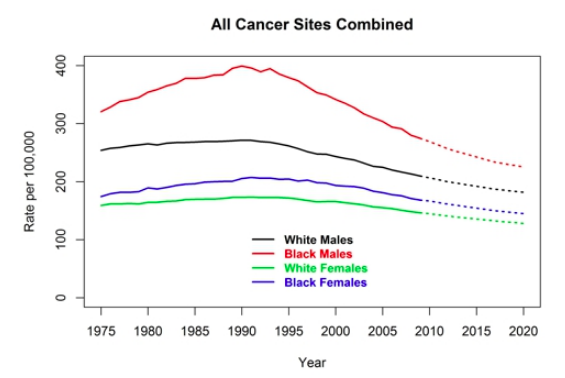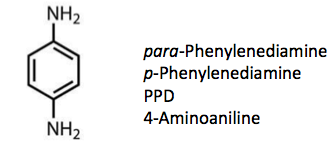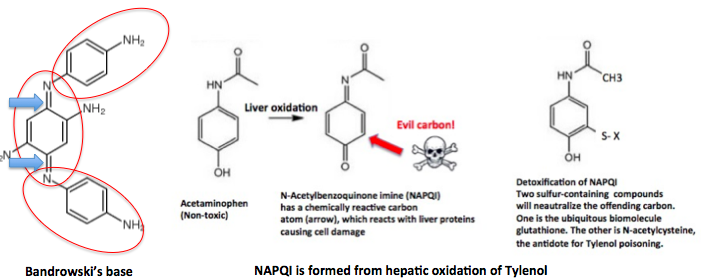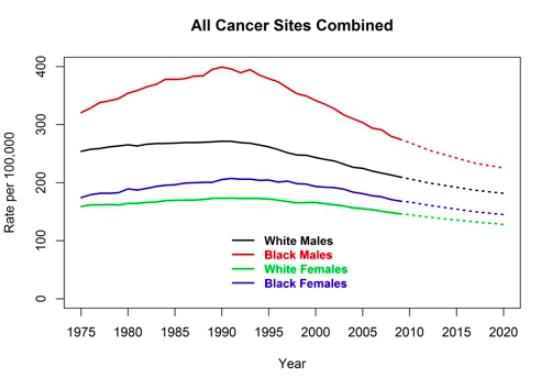There are so many chemicals accused of causing human cancers that it's a wonder that any of us are still breathing. Yet, we are. In fact, since 1975 rates of most cancers have been either steady or slowly declining (Figure 1). So, these claims must be false; either the chemicals in question are not really carcinogenic or humans are not being exposed to enough of them to make a difference.

Rates of cancers of all sites 1975-2020. Source: CDC
When friends and relatives ask me whether Chemical A or Chemical B will give them cancer my reply is usually "nonsense." But not with hair dyes. There is a chemical in hair dyes called para-phenylenediamine, a/k/a 4-aminoaniline, or PPD, that at least warrants some respect and consideration. At least as seen through the eyes of a chemist. Here's why.

The chemical structure and four common names of PPD
PPD itself is not carcinogenic (1), but it is rather toxic. Some people develop skin hypersensitivity that can be rather nasty. But other chemicals are used in the dying process; one of them is hydrogen peroxide. Peroxide reacts with PPD to give something called Bandrowski's base (Figure 2, left), which is highly mutagenic and possibly carcinogenic. Bandrowski's base is a trimeric oxidation product of PPD. The three PPD units are shown in red ovals. The blue arrows indicate the chemically reactive (dangerous) portion of the molecule - the carbon-nitrogen double bonds.

Tylenol (Figure 2, right) provides a similar case - a molecule being activated by oxidization (in this case by the liver) to form something more dangerous than the parent compound. Tylenol itself is not harmful, but once oxidized by you now have in your blood a seriously bad liver toxin called N-acetylbenzoquinone imine (NAPQI), which is the bad actor, not Tylenol itself. The red arrow shows the chemically reactive (2) fragment of the molecule, a carbon-oxygen double bond.
Life doesn't always follow the rules of chemistry and biochemistry. It would be difficult for any well-trained medicinal chemist to look at the structures of the oxidation products of PPD and Tylenol and not raise an eyebrow or two. While the structures of both oxidation products are potentially harmful, NAPQI (from Tylenol) is, while Bandrowski's base (from PPD) is not, at least no as used (3). Just one of the many quirks of organic chemistry. No reason to pull your hair out. Or let it get gray.
WHAT ABOUT HAIR DYE AND CARCINOGENICITY?
My colleague Alex Berezow just published an article on the results of a very large 36-year study that looks at the hair dye-cancer link (or lack thereof). You can read his analysis here.
NOTES
(1) IARC (International Agency for Research on Cancer), a subsidiary of the WHO, isn't the least bit reluctant to label a chemical a carcinogen, deserved or not. But even they don't claim that PPD is a carcinogen. It is categorized as “not classifiable as to its carcinogenicity to humans” See my colleague Dr. Alex Berezow's vicious takedown of IARC's corrupt decision to categorize glyphosate as a carcinogen, even though it isn't.
(2) Chemical reactivity is almost always a big no-no in drugs. Reactive molecules modify different amino acids in proteins. Your body doesn't appreciate this.
(3) Why is Bandrowski's not carcinogenic? Hard to say. It could be any number of reasons, like insufficient exposure or lack of absorption through the skin. My money says it's the second.




